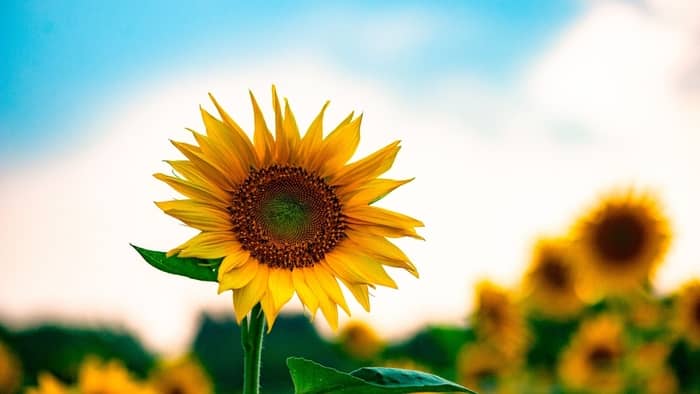Last Updated on August 22, 2022 by Griselda M.
What do brown spots on sunflower leaves mean and do they affect the health of the plant?
Helianthus annuus L., commonly known as sunflower is a biennial herbaceous plant native to North and South America. It has been cultivated for its edible seeds, oil, and nutritious leaves and stems.
Sunflower is used as a source of vegetable oil, protein-rich food, and fodder. It is an important source of animal feed, including poultry, fish, swine, and dairy cattle. It also can be used as a green manure crop and a cover crop for erosion control.
Sunflower is grown globally with an average production of 56,072,746 tonnes per year. Russia is the top-ranked producer with a production of 15,379,287 tonnes per year, it is followed by Ukraine with 15,254,120 tonnes per year. These two countries put together produce about 50% of the total sunflower.
Sunflower oil is used in soap, margarine, cooking, cosmetics, and pharmaceuticals. It is also used in printing inks, paints, varnishes, and other industrial products. Sunflower oil has high levels of unsaturated fatty acids, such as oleic acid and linoleic acid which are important components of human diets.
It also contains vitamins A, B, and C, and minerals such as calcium, iron, phosphorus, magnesium, zinc, and copper. The nutritional composition of sunflower oil can vary based on the genetics of the plant and on the conditions under which it is grown.
Sunflower plants suffer from common diseases like brown spots on their leaves. Let’s take a look at what they mean and the effects they can have on these plants.
What Are The Brown Spots On Sunflower Leaves?
Although sunflowers are hardy plants, when they are still young or newly planted, certain factors can cause them to develop undesirable brown spots. Let’s have a look at these causes.
What Causes Brown Spots On Sunflower Leaves?
Rust disease
Sunflower rust is caused by the fungus Puccinia helianthi. This fungus causes brown spots on the top and bottom of the sunflower leaf. The fungal spores appear in the summer and spread to newly planted and susceptible plants, causing these spots.
This disease can also affect crops such as wheat, beans, maize, sugarcane, blueberry, and groundnuts. To limit its spread, it is important to reduce the moisture of the soil. This is because rust disease thrives in high humidity. You can also cut off bits (about 1/3) of the affected part of the plant at a time, and keep repeating until your sunflower has recovered.
Downy mildew
Downy mildew is another possible cause of brown spots on sunflower leaves. This is one of the most dangerous sunflower diseases as it not only affects the leaves but can also infect the stem and buds of the plant.
It appears as a fluffy mass on the bottom of the sunflower leaf. The application of an organic copper fungicide for a period of about a week is best to solve this problem.
Sunflower beetle damage
Sunflower beetle is a commonly found pathogen in the United States. If you look closely at your sunflower leaves and notice a moving insect, it may be the beetle that may have been eating away at your plant.
To get rid of the beetle problem, use an organic insecticide. It will prevent the bottle from growing and multiplying, and will keep your plants looking happy and healthy.
Fungal wilting
Sunflowers are climate sensitive and water loving plants. If the climate in which they are grown is not ideal, or they are not being provided with sufficient water they can become stressed and susceptible to fungal infections from soil borne pathogens such as fungi
The way to deal with this problem, unfortunately, will be to remove the affected plants to prevent the infection from spreading. And the next time a new crop is planted, it should be planted in a different place to avoid history repeating itself.
Leaf diseases
Certain environments such as the Mediterranean climate provide a good breeding ground for many leaf diseases which if left untreated can be absolutely detrimental to your sunflower crop. And some of these diseases present as brown spots on the plant leaves.
Pathogens that attack sunflower plants are usually present in the soil, infect newly planted seedlings and as they grow, weaken and destroy them. The best way to deal with this issue is to use organic fungicides to kill any pathogens that may be present in the soil before new sunflowers are planted.
Backyard Safari Company Grow Gardens, Sunflower
Read more about Do You Know How Late Can You Plant Sunflowers?

Final Comments
The brown spots on your sunflower leaves may be an indication of fungal infections or other highly contagious diseases. These diseases can be controlled by keeping the infected plants away from healthy ones. They can also be controlled by applying the right organic fungicides or insecticides following the right diagnoses.
Frequently Asked Questions
How do you get rid of fungus on sunflowers?
You can get rid of fungal infections of sunflowers by using the following methods. - Remove and destroy infected seeds, seedlings or plants. - Wash with a 10% bleach solution (1 part bleach to 9 parts water). - Spray with a fungicide, such as copper. - Sprinkle with lime or sulfur. - Grow in moist soil.
What is wrong with my sunflower leaves?
The leaves may look yellow, mottled, crinkled or puckered. This condition is called sunflower leaf scorch. Leaf scorch is caused by damage to the chloroplasts of the leaf cells. The chloroplasts are the part of the cell that makes food for the plant. In some cases, leaf scorch is caused by a disease, such as a sunflower mosaic virus or sunflower necrotic yellows virus. In other cases, it may be caused by environmental conditions, including drought stress, high temperatures, nutrient deficiencies, and high light levels.
What does fungus on sunflowers look like?
Fungal infection on sunflowers may appear as brown or black spots, white mass on the leaves or the wilting and dropping off of leaves. They can be caused by different types of fungi. It is therefore important to make the correct diagnosis before these symptoms can be treated.
How do you treat black spots on sunflower leaves?
Black spots on sunflower may be a result of a fungal infection. The best way to deal with a fungal infection on sunflower leaves is to apply an organic fungicide. You can consult your local gardening store to get the best one.
Caroline is a gardener who loves to get down to the nitty–gritty of gardening. She proudly proclaims herself as a ‘dirt worshipper‘ and can often be found deep in the garden, covered in soil and singing to her plants. As a self–proclaimed ‘plant whisperer‘, Caroline believes that plants need love and attention just like any other living thing, and she loves to give them both. When she‘s not tending to her garden, you can often find her researching the latest gardening trends, or teaching others how to make their gardens thrive



